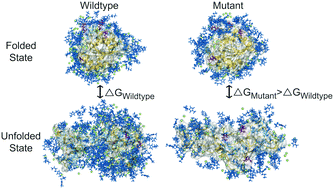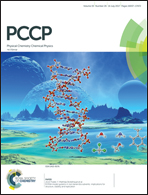Elucidating sequence and solvent specific design targets to protect and stabilize enzymes for biocatalysis in ionic liquids†
Abstract
For many different frameworks, the structure, function, and dynamics of an enzyme is largely determined by the nature of its interactions with the surrounding host environment, thus a molecular level understanding of enzyme/host interactions is essential to the design of new processes and applications. Ionic liquid (IL) solvents are a popular class of solvents in which to study enzyme behavior, yet it is still not possible to predict how a given enzyme will behave in a given IL solvent. Furthermore, a dearth of experimental data with which to evaluate simulation force fields has prevented the full integration of experimental and computational techniques to gain a complete picture of enzyme/IL interactions. Utilizing recently published crystallographic data of an enzyme in complex with an IL, this study aims to validate the use of current molecular force fields for studying enzyme/IL interactions, and to provide new mechanistic insight into enzyme stabilization in IL solvents. Classical molecular dynamics (MD) simulations have been performed on both the folded and unfolded state of Bacillus subtilis lipase A and a quadruple-mutant version of lipase A, in solutions of aqueous 1-butyl-3-methylimidazolium chloride. Results show classical MD simulations can predict the preferred surface binding locations of IL cations as well as reductions in IL anion binding to mutated surface residues with high accuracy. The results also point to a mechanistic difference between IL binding to the folded and unfolded state of an enzyme, which we call the “counter-ion effect”. These findings could have important implications for future rational design efforts to stabilize enzymes in non-conventional media.



 Please wait while we load your content...
Please wait while we load your content...